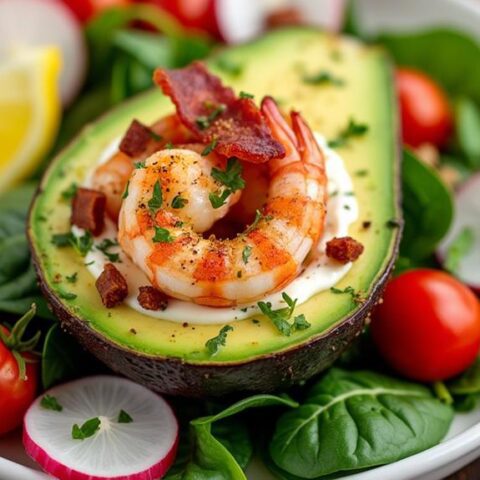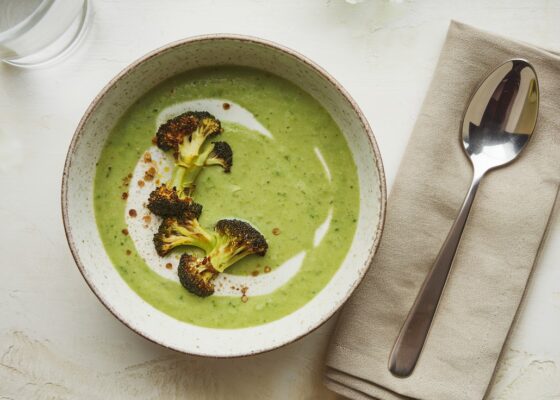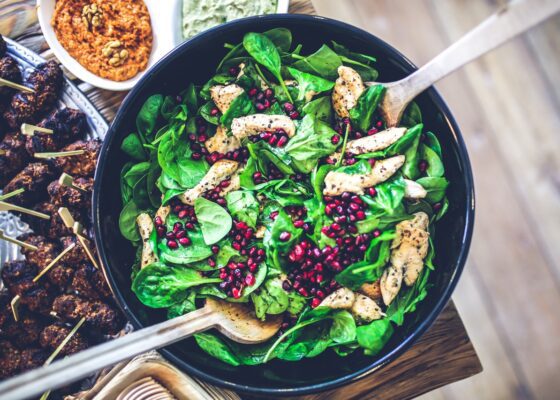
Pork is an excellent choice for low-carb diets, containing zero net carbohydrates per 100g serving while delivering substantial protein and essential nutrients. All cuts maintain this carb-free profile, from lean tenderloin to fatty bacon, though fat content varies between cuts. The meat provides B-complex vitamins, minerals like zinc and selenium, and high-quality protein that supports muscle maintenance and growth. Understanding specific cuts and cooking methods can maximize pork's nutritional benefits in a low-carb lifestyle.
Key Takeaways
- Pork contains zero net carbohydrates per 100g serving, making it an ideal choice for low-carb and ketogenic diets.
- All pork cuts, from bacon to tenderloin, maintain zero carbs while offering varying fat content to suit different dietary needs.
- Fresh pork provides essential nutrients like protein and B-vitamins without impacting blood sugar levels due to its zero glycemic index.
- Processed pork products may contain hidden carbohydrates from additives, so always check labels and choose fresh cuts when possible.
- Grilling, roasting, and pan-searing are excellent low-carb cooking methods that maintain pork's carb-free status while enhancing flavor.
Understanding Pork's Role in Low-Carb Diets
Pork stands as one of the most reliable protein sources for individuals following a low-carb dietary approach, containing zero net carbohydrates per 100-gram serving. This characteristic makes it particularly valuable for those adhering to ketogenic diet protocols or other low-carb diet variations that require strict carbohydrate monitoring. The health benefits of incorporating pork into a low-carb eating plan extend beyond its carbohydrate profile. With a balanced composition of approximately 50% fat and 40% protein, pork provides essential nutrients while maintaining metabolic stability. Its rich mineral content, including potassium, magnesium, and zinc, supports overall health without compromising carbohydrate restrictions. Additionally, pork's zero glycemic index guarantees blood sugar levels remain stable, making it an excellent choice for those managing their carbohydrate intake through dietary intervention. Moreover, pork offers a variety of cooking techniques that can enhance flavor and preserve nutrients, making it a versatile addition to any low-carb meal plan.
The Carbohydrate Content of Different Pork Cuts
Various cuts of pork, from tenderloin to bacon, consistently maintain zero net carbohydrates per 100 grams, making them excellent choices for low-carb dietary plans.
While the carbohydrate content remains constant across different cuts, the fat content varies considerably, with bacon and pork belly containing higher fat percentages compared to leaner options like tenderloin and pork chops.
Understanding these fat-to-carb ratios allows individuals following low-carb diets to select pork cuts that best align with their specific nutritional goals and caloric requirements. Additionally, choosing high-fat pork cuts can support the ketogenic diet's mechanism of ketosis, which enhances fat burning and helps regulate appetite.
Pork Cut Carb Comparison
Examining different cuts reveals a consistent pattern in their carbohydrate content, as every variety of pork contains zero net carbs per 100 grams.
When conducting a pork cut carb comparison, both fatty and lean cuts demonstrate identical carbohydrate profiles, making them equally suitable for low-carb dietary needs.
While pork belly offers higher fat content for those seeking energy-dense options, lean cuts like tenderloin provide protein-focused alternatives without introducing carbohydrates.
Understanding these consistent characteristics allows consumers to make informed choices based on their specific nutritional goals rather than carbohydrate concerns.
The universal low in carbohydrates nature of pork cuts simplifies meal planning for those following ketogenic or carb-restricted diets, regardless of their preferred cut selection.
Fat-to-Carb Ratio Analysis
The relationship between fat content and carbohydrates in meat products plays a significant role in dietary planning, particularly when considering different pork cuts.
Analysis reveals that pork consistently maintains a favorable fat-to-carb ratio across various cuts, with virtually zero net carbohydrates per 100 grams. Pork belly stands out as being particularly high in fat while remaining low in carbs, making it an excellent choice for ketogenic diets.
Different cuts of pork offer varying fat profiles while maintaining minimal carbohydrate content. For instance, lean cuts like tenderloin provide more protein with less fat, while ground pork typically contains higher fat content.
When selecting pork products, it's important to examine nutrition labels carefully, as some processed varieties may contain additional ingredients that could affect the overall carbohydrate content.
Essential Nutrients Found in Pork
Nutritional powerhouse pork delivers an impressive array of essential nutrients that support overall health and bodily functions. This versatile meat contains high-quality protein, providing 21.1g per 100g serving, which aids in muscle maintenance and repair. Beyond protein, pork offers a rich profile of minerals and vitamins, particularly B-complex vitamins, including B12 for energy production and nerve health.
| Nutrient | Benefit |
|---|---|
| Protein | Muscle repair and maintenance |
| B Vitamins | Energy production and nerve health |
| Potassium | Electrolyte balance and heart function |
| Magnesium | Bone health and energy metabolism |
| Healthy Fats | Cardiovascular support |
The combination of healthy fats and zero glycemic impact makes pork an excellent choice for those monitoring their carbohydrate intake while seeking essential nutrients.
Best Cooking Methods for Low-Carb Pork Dishes
Grilling stands out as an excellent method for preparing low-carb pork dishes, allowing fat to drip away while intensifying the meat's natural flavors.
Pan-searing pork chops creates a golden-brown crust that seals in moisture, making it an ideal technique for maintaining the meat's low-carb profile while maximizing taste.
These cooking methods, when combined with appropriate seasonings and healthy fats, enable home cooks to prepare flavorful pork dishes that align perfectly with low-carb dietary goals.
Grilling for Maximum Flavor
Mastering the art of grilling pork reveals exceptional flavors while maintaining its naturally low-carb profile, making it an ideal cooking method for health-conscious food enthusiasts.
The grilling process renders fat effectively, enhancing taste while supporting healthy fats consumption essential for low-carb diets.
To maximize flavor while keeping carbohydrates at zero, marinating pork with olive oil, garlic, and fresh herbs creates depth without adding unnecessary carbs.
Using a meat thermometer to achieve the best internal temperature of 145°F guarantees perfectly cooked, juicy results.
For a complete low-carb meal, pairing grilled pork with compatible vegetables like zucchini or asparagus maintains dietary goals while offering a satisfying dining experience.
Pan-Searing Perfect Pork Chops
When seeking the perfect low-carb cooking method for pork, pan-searing stands out as a superior technique that creates a golden-brown crust while preserving the meat's natural moisture.
This keto-friendly approach requires high smoke point oils, such as avocado oil or grass-fed butter, to achieve ideal results and enhance flavor profiles.
For the perfect pan-seared pork chops, follow these essential steps:
- Heat oil in a skillet over medium-high heat until shimmering
- Sear pork chops for 3-4 minutes per side until golden brown
- Monitor internal temperature until reaching 145°F (63°C)
- Season with low-carb herbs and spices like garlic powder or rosemary
Complete this low-carb meal by pairing the pan-seared pork chops with complementary sides such as sautéed spinach or cauliflower mash for a well-balanced dining experience.
Top Pork Cuts for Low-Carb Meal Planning
For those following a low-carb lifestyle, selecting the right cuts of pork can make meal planning both enjoyable and nutritionally sound. Various pork cuts offer excellent options for maintaining ketogenic or low-carb diets while providing essential nutrients and moderate protein levels.
| Cut Type | Net Carbs (per 100g) | Best Cooking Method |
|---|---|---|
| Pork Belly | 0.0g | Roasting/Braising |
| Bacon | 0.0g | Pan-frying |
| Pork Loin | 0.0g | Roasting/Grilling |
| Tenderloin | 0.0g | Pan-searing |
| Ground Pork | 0.0g | Multiple Methods |
High-fat cuts like pork shoulder and spare ribs deliver the necessary fat content while maintaining zero carbohydrates. Leaner options such as tenderloin provide flexibility in meal preparation without compromising low-carb requirements. Each cut contains valuable minerals like zinc and phosphorus, supporting overall health while adhering to carb restrictions. The ketogenic diet not only assists in managing blood glucose levels but also enhances insulin sensitivity, making it beneficial for individuals with type 2 diabetes.
Health Benefits of Including Pork in Your Diet
Pork stands out as a nutrient-dense protein source that delivers essential amino acids necessary for muscle maintenance and repair while containing zero carbohydrates.
The meat's rich mineral profile, including zinc, phosphorus, and potassium, supports various bodily functions from immune system health to bone strength.
Beyond its protein content, pork provides important B-vitamins and selenium, making it a valuable addition to a balanced, low-carb eating plan.
Nutrient-Rich Protein Source
A powerhouse of nutrition, lean pork stands out as an exceptional protein source while maintaining its status as a zero-carb food option.
As a low-carb protein source, pork delivers an impressive 21.1g of protein per 100g serving, making it an excellent choice for those following ketogenic or low-carb dietary plans.
- Contains zero net carbs per serving, perfect for strict carb monitoring
- Rich in essential nutrients including potassium, magnesium, and zinc
- High protein content supports muscle maintenance and growth
- Moderate fats contribute to lasting satiety and stable energy levels
The combination of high protein content and beneficial minerals makes pork a nutrient-dense option for health-conscious individuals.
Its zero glycemic index guarantees blood sugar stability, while its satiating properties help prevent overeating during meal times.
Essential Minerals and Vitamins
Beyond its protein content, the nutritional profile of pork reveals an impressive array of minerals and vitamins that support peak health. This meat delivers essential nutrients including potassium, phosphorus, magnesium, and zinc, which are fundamental for maintaining proper bodily functions.
The abundance of B vitamins, particularly B6 and B12, plays a vital role in energy metabolism and the formation of red blood cells.
As a protein source with a low glycemic index of zero, pork provides sustained energy without causing blood sugar spikes. The presence of tryptophan, an important amino acid, contributes to improved mood and relaxation.
These vitamins and minerals, combined with pork's high-quality protein content, make it a valuable addition to a balanced diet, supporting overall health and well-being.
Common Misconceptions About Pork and Carbs
When it comes to understanding pork's role in low-carb diets, several persistent misconceptions can lead people astray. Despite common beliefs, pork contains zero net carbohydrates per 100 grams, making it an excellent choice for ketogenic and low-carb eating plans.
Many individuals incorrectly assume that all meats, including pork, contain significant carbohydrates.
Common myths about pork and carbohydrates include:
- The belief that fatty cuts of pork must contain carbohydrates
- Assuming all processed pork products are high in carbs
- Thinking pork contains more carbohydrates than other meats
- Misconceptions about pork's compatibility with ketogenic diets
Pork is a reliable low-carb protein that aligns with the principles of the keto diet, which emphasizes low carbohydrate intake and high fats.
Understanding these facts helps dispel confusion and confirms pork's status as a reliable low-carb protein source, suitable for various dietary approaches focused on carbohydrate restriction.
Selecting Quality Pork for Low-Carb Cooking
Selecting quality pork cuts stands as an essential first step for maintaining a successful low-carb diet. When choosing pork for healthy, low-carb meals, focus on fresh, unprocessed cuts like pork belly, loin, and chops, which contain zero net carbs per 100 grams. Opt for organic or pasture-raised options to guarantee higher quality meat with fewer additives and antibiotics.
| Cut Type | Net Carbs | Best Cooking Method |
|---|---|---|
| Pork Belly | 0g | Pan-frying |
| Pork Loin | 0g | Roasting |
| Pork Chops | 0g | Grilling |
| Fresh Ham | 0g | Roasting |
When shopping, carefully examine nutritional labels, particularly on processed pork products, as they may contain hidden carbs from added sugars or fillers. Choose preparation methods like grilling or roasting to maintain the meat's natural low-carb properties while maximizing flavor.
Pairing Pork With Other Low-Carb Foods
To create a well-balanced low-carb meal, pork can be expertly paired with numerous complementary ingredients that maintain minimal carbohydrate content while maximizing nutritional value.
When planning pork-based dishes, focus on incorporating healthy fats and non-starchy vegetables to enhance both flavor and nutritional benefits.
Including high-fat dairy options like full-fat cheese can enrich pork dishes with flavor while keeping carbs low.
Key pairings for delicious low-carb pork dishes include:
- Nutrient-dense vegetables like broccoli, spinach, and zucchini
- Heart-healthy fats such as avocado and olive oil
- Cauliflower rice as a grain substitute
- Fresh leafy greens including arugula and kale for salads
Seasoning with herbs and spices adds variety without compromising carbohydrate restrictions.
These thoughtful combinations guarantee satisfying meals while maintaining ketogenic principles, offering both versatility and compliance with low-carb dietary requirements.
Portion Control Guidelines for Pork
Proper portion control stands at the heart of any successful low-carb eating plan, particularly when incorporating pork into daily meals. When following a keto diet, monitoring portion sizes helps maintain ideal fat content while preventing excess protein consumption that could impact ketosis through gluconeogenesis. A key benefit of the ketogenic diet is its ability to enhance metabolic health and insulin management, which is crucial for maintaining energy balance and fat metabolism.
| Portion Type | Serving Size | Carbohydrate Intake |
|---|---|---|
| Small | 85g | 0.0g |
| Standard | 100g | 0.0g |
| Large | 150g | 0.0g |
Using digital tracking tools to monitor portions guarantees accurate measurement of daily macronutrient ratios. While pork contains zero carbs, balancing portions with low-carb vegetables creates nutritionally complete meals. For those following strict ketogenic protocols, selecting fattier cuts of pork can help meet dietary fat requirements while maintaining appropriate serving sizes.
Storing and Preparing Pork for Maximum Nutrition
Maintaining pork's nutritional value requires careful attention to storage and preparation methods that preserve its essential nutrients while guaranteeing food safety.
When storing pork, refrigerate for 3-5 days or freeze for up to 6 months to maintain quality.
For ideal preparation, consider these key guidelines:
- Select cuts with higher fat content, such as pork belly or shoulder, which provide essential fats suitable for low-carb diets.
- Enhance flavor using keto-friendly ingredients in marinades, combining olive oil with herbs and spices.
- Employ dry cooking methods like grilling or baking to preserve natural moisture and nutrients.
- Cook pork to an internal temperature of 145°F (63°C) for food safety while retaining nutritional benefits.
These storage and preparation techniques guarantee both safety and maximum nutritional value, making pork an excellent choice for health-conscious consumers.
Meal Planning Tips for Pork-Based Low-Carb Diets
Successful meal planning for pork-based low-carb diets begins with understanding how to effectively incorporate this versatile protein into daily meals while maintaining strict carbohydrate limits. Creating a structured meal plan guarantees proper portion sizes while maximizing nutritional benefits.
| Meal Time | Pork Option | Low-Carb Side |
|---|---|---|
| Breakfast | Bacon | Eggs & Avocado |
| Lunch | Pork Chops | Broccoli |
| Dinner | Tenderloin | Zucchini |
Strategic meal preparation involves cooking pork dishes in advance, which helps maintain consistent portion control throughout the week. By combining different cuts of pork with low-carb vegetables, individuals can create satisfying meals that align with their dietary goals. Utilizing various cooking methods, such as grilling or baking, adds variety while keeping carbohydrate content at zero. Regular monitoring of blood sugar and ketones is crucial during the keto diet adjustment phase to avoid hypoglycemia.
Frequently Asked Questions
Is Pork Good for a Low Carb Diet?
Pork's nutritional benefits align perfectly with low-carb diets, offering zero carbs and high protein. Various cooking methods and pork meal ideas support weight loss while maintaining ketosis through versatile preparation options.
Is Pork Better Than Beef for Keto?
Comparing pork nutrition with beef fat content reveals both are keto friendly meats. Pork's lower calories, zero carbs, and higher protein content make it marginally better for maintaining ketosis than beef.
Is Pork a Low Quality Meat?
Pork quality varies based on meat grading standards, with properly sourced cuts offering significant nutritional value, including essential proteins and minerals. Health implications depend on cut selection and preparation methods.
Why Is Pork Not Keto?
Examining pork nutrition facts reveals pork is actually keto-friendly. With zero carbohydrate levels and high pork fat content, it's comparable to chicken in protein while offering more fat-rich options for ketogenic diets.
Conclusion
Pork serves as an excellent protein choice for those following low-carb diets, containing virtually no carbohydrates while offering essential nutrients and versatility in preparation. With proper selection of lean cuts, mindful portion control, and appropriate cooking methods, pork can be a cornerstone of healthy low-carb meal planning. By incorporating pork alongside complementary low-carb vegetables and maintaining proper storage practices, individuals can successfully integrate this protein-rich meat into their nutritional goals.










No Comments